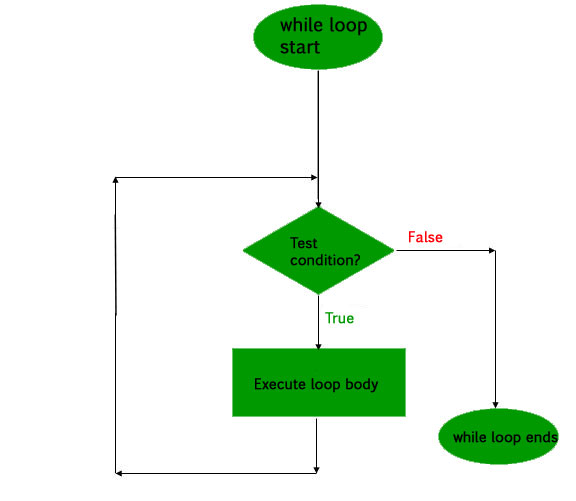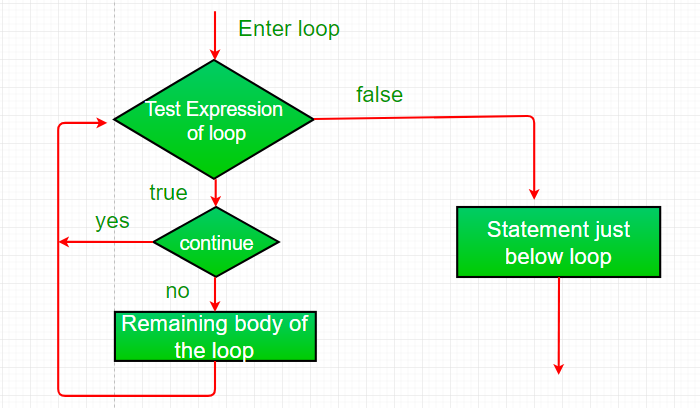Loops in C#
Last Updated :
20 Mar, 2023
Looping in a programming language is a way to execute a statement or a set of statements multiple times depending on the result of the condition to be evaluated to execute statements. The result condition should be true to execute statements within loops. Loops are mainly divided into two categories: Entry Controlled Loops: The loops in which condition to be tested is present in beginning of loop body are known as Entry Controlled Loops. while loop and for loop are entry controlled loops. 1. while loop The test condition is given in the beginning of the loop and all statements are executed till the given Boolean condition satisfies when the condition becomes false, the control will be out from the while loop. Syntax:
while (boolean condition)
{
loop statements...
}
Flowchart:  Example:
Example:
csharp
using System;
class whileLoopDemo
{
public static void Main()
{
int x = 1;
while (x <= 4)
{
Console.WriteLine("GeeksforGeeks");
x++;
}
}
}
|
Output:
GeeksforGeeks
GeeksforGeeks
GeeksforGeeks
GeeksforGeeks
Time Complexity: O(1)
Auxiliary Space: O(1)
2. for loop for loop has similar functionality as while loop but with different syntax. for loops are preferred when the number of times loop statements are to be executed is known beforehand. The loop variable initialization, condition to be tested, and increment/decrement of the loop variable is done in one line in for loop thereby providing a shorter, easy to debug structure of looping.
for (loop variable initialization ; testing condition;
increment / decrement)
{
// statements to be executed
}
Flowchart:  1. Initialization of loop variable: Th expression / variable controlling the loop is initialized here. It is the starting point of for loop. An already declared variable can be used or a variable can be declared, local to loop only. 2. Testing Condition: The testing condition to execute statements of loop. It is used for testing the exit condition for a loop. It must return a boolean value true or false. When the condition became false the control will be out from the loop and for loop ends. 3. Increment / Decrement: The loop variable is incremented/decremented according to the requirement and the control then shifts to the testing condition again. Note: Initialization part is evaluated only once when the for loop starts. Example:
1. Initialization of loop variable: Th expression / variable controlling the loop is initialized here. It is the starting point of for loop. An already declared variable can be used or a variable can be declared, local to loop only. 2. Testing Condition: The testing condition to execute statements of loop. It is used for testing the exit condition for a loop. It must return a boolean value true or false. When the condition became false the control will be out from the loop and for loop ends. 3. Increment / Decrement: The loop variable is incremented/decremented according to the requirement and the control then shifts to the testing condition again. Note: Initialization part is evaluated only once when the for loop starts. Example:
csharp
using System;
class forLoopDemo
{
public static void Main()
{
for (int x = 1; x <= 4; x++)
Console.WriteLine("GeeksforGeeks");
}
}
|
Output:
GeeksforGeeks
GeeksforGeeks
GeeksforGeeks
GeeksforGeeks
Time Complexity: O(1)
Auxiliary Space: O(1)
Exit Controlled Loops: The loops in which the testing condition is present at the end of loop body are termed as Exit Controlled Loops. do-while is an exit controlled loop. Note: In Exit Controlled Loops, loop body will be evaluated for at-least one time as the testing condition is present at the end of loop body. 1. do-while loop do while loop is similar to while loop with the only difference that it checks the condition after executing the statements, i.e it will execute the loop body one time for sure because it checks the condition after executing the statements. Syntax :
do
{
statements..
}while (condition);
Flowchart:  Example:
Example:
csharp
using System;
class dowhileloopDemo
{
public static void Main()
{
int x = 21;
do
{
Console.WriteLine("GeeksforGeeks");
x++;
}
while (x < 20);
}
}
|
Output:
GeeksforGeeks
Infinite Loops: The loops in which the test condition does not evaluate false ever tend to execute statements forever until an external force is used to end it and thus they are known as infinite loops. Example:
csharp
using System;
class infiniteLoop
{
public static void Main()
{
for(;;)
Console.WriteLine("This is printed infinite times");
}
}
|
Output:
This is printed infinite times
This is printed infinite times
This is printed infinite times
This is printed infinite times
This is printed infinite times
This is printed infinite times
This is printed infinite times
..........
Nested Loops: When loops are present inside the other loops, it is known as nested loops. Example:
csharp
using System;
class nestedLoops
{
public static void Main()
{
for(int i = 2; i < 3; i++)
for(int j = 1; j < i; j++)
Console.WriteLine("GeeksforGeeks");
}
}
|
Output:
GeeksforGeeks
continue statement: continue statement is used to skip over the execution part of loop on a certain condition and move the flow to next updation part. Flowchart:  Example:
Example:
csharp
using System;
class demoContinue
{
public static void Main()
{
for(int i = 1; i < 3; i++)
{
if(i == 2)
continue;
Console.WriteLine("GeeksforGeeks");
}
}
}
|
Output:
GeeksforGeeks
Time Complexity: O(1)
Auxiliary Space: O(1)
Like Article
Suggest improvement
Share your thoughts in the comments
Please Login to comment...